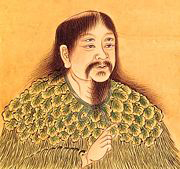a talismanic significance
“Blue was a color which had for him, with his host of superstitions, a talismanic significance. It was the color of his eyes and the color which would grace the cover of the first edition of Ulysses. . . .”
—Edna O’Brien, James Joyce, 1999.
purple monkey dishwasher
We’ve all heard the expression ‘purple monkey dishwasher,’ of course we have! But what does it mean? Well . . . if you have to ask, then you don’t know. And if you don’t know . . . just check The Urban Dictionary.
Design Classics: The London Underground Map
 If you appreciate good design and have 25 minutes for a relaxing spot of twentieth-century British telly, you might enjoy this.
If you appreciate good design and have 25 minutes for a relaxing spot of twentieth-century British telly, you might enjoy this.
a mixture of wine, blood, and squid-ink
“Artist through, I’d been wont since boyhood when pissing on beach or bank to make designs and clever symbols with my water. From this source, as from Pegasus’s idle hooftap on Mount Helicon, sprang now a torrent of inspiration: using tanned skins in place of a sand-beach, a seagull-feather for my tool, and a mixture of wine, blood, and squid-ink for a medium, I developed a kind of coded markings to record the utterance of mind and heart. By drawing out these chains of symbols I could so preserve and display my tale, it was unnecessary to remember it. I could therefore compose more and faster; I came largely to exchange song for written speech. . . .”
—John Barth, ‘Anonymiad’, Lost in the Funhouse, 1968.
a rousing good yarn
“If I’m going to be a fictional character G declared to himself I want to be in a rousing good yarn as they say, not some piece of avant-garde preciousness.”
—John Barth, ‘Life-Story’, Lost in the Funhouse, 1968.
Cang Jie, the legendary creator of the Chinese script
 “Zhang Huaiguan, a well-known calligraphic theorist of the Tang dynasty, claimed in his Critical Reviews on Calligraphy (Shu duan) that Cang Jie, the legendary creator of the Chinese script . . . had four eyes that were capable of communing with the Divinity. ‘He looked up to observe the changing view of the constellations, and gazed around to scrutinize the patterns on turtle shells and the tracks of birds and beasts. He picked a wide variety of beautiful forms and combined them into characters.’ According to Zhang, character construction occurs when people commune with nature and merge its beauty with their own spirit.”
“Zhang Huaiguan, a well-known calligraphic theorist of the Tang dynasty, claimed in his Critical Reviews on Calligraphy (Shu duan) that Cang Jie, the legendary creator of the Chinese script . . . had four eyes that were capable of communing with the Divinity. ‘He looked up to observe the changing view of the constellations, and gazed around to scrutinize the patterns on turtle shells and the tracks of birds and beasts. He picked a wide variety of beautiful forms and combined them into characters.’ According to Zhang, character construction occurs when people commune with nature and merge its beauty with their own spirit.”
—Ouyang Zhongshi & Wen C. Fong, Chinese Calligraphy, translated & edited by Wang Youfen, 2008.
the liveliness of ancient characters
“Commenting on the liveliness of ancient characters, Wei Heng (259-291), a calligrapher of the Western Jin dynasty, wrote in his On the Four Types of Scripts (Si ti shu shi) that they evoke ‘patches of clouds drifting leisurely in the sky, myriads of stars blinking from above, crops heavily laden with drooping ears, mountains undulating into folds, insects ready to crawl away, and birds just starting to take flight.’”
—Ouyang Zhongshi & Wen C. Fong, Chinese Calligraphy, translated & edited by Wang Youfen, 2008.
cursive script
“The celebrated Tang dynasty writer Han Yu described how his contemporary Zhang Xu, a master in cursive script, was able to create a calligraphic counterpart for what he saw in nature: ‘mountains and rivers, valleys and cliffs, birds and animals, insects and fish, the flowering of trees and the seeding of grass; sun and moon, the constellations, wind and rain, water and fire, thunder and lightning, dancing and fighting, and the vicissitudes of all things in heaven and earth. Rejoicing over them, amazed by them, he would express them through his calligraphy. . . .’ This depth of expression available through the cursive script gave readers a level of aesthetic enjoyment that often exceeded their expectations.”
—Ouyang Zhongshi & Wen C. Fong, Chinese Calligraphy, translated & edited by Wang Youfen, 2008.
November 5, 2008: The Day in 100 Seconds
A Metamorphosis for the Eighties
“‘What’s with these titles? “Dance of the Insecure”? “To the Mall”?
“Threnody Jones and the Goat from Below”? “The Enema Bandit and the
Cosmic Buzzer”? “Love”? “A Metamorphosis for the Eighties”?’
‘That last one is actually rather interesting. A
Kafka parody, though sensitively done.
Self-loathing-in-the-midst-of-adulation piece. Collegiate, but
interesting.’
‘ “As Greg Sampson awoke one morning from uneasy
dreams he discovered that he had been transformed into a rock star. He
gazed down at his red, as it were leather-clad, chest, the top of which
was sprinkled with sequins and covered with a Fender guitar strapped
tightly across his leather shoulders. It was no dream.” Hmmm.’”
—David Foster Wallace, The Broom of the System, 1987.